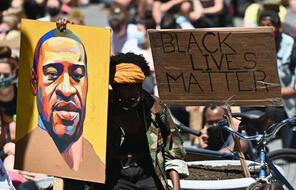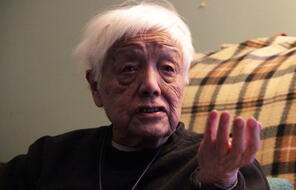
Paragraph 175 & the Origins of the Pink Triangle
During WWII and the Holocaust, the Nazi party targeted a number of groups for incarceration, dehumanization and death. In the concentration, labor and death camps, various groups had a symbol sewn to their uniforms to indicate the reasons the Nazis chose to imprison them. Among the targeted groups were men identified as gay by the Nazi regime. These men were forced to wear pink triangles sewn to their uniforms. Due to the work and activism of LGBTQIA+ communities across the world, the pink triangle has been reclaimed as a symbol of pride and remembrance for the last fifty years.
LGBTQIA+ communities in the former West Germany, and later in New York City, were among the first to reclaim the pink triangle as a source of pride and remembrance in the 1960s and 1970s. It became more widely known in popular culture in the mid-1980s when a group of gay activists created a poster with an upturned pink triangle and the phrase “Silence=Death” to publicize the inaction and homophobia of institutions during the AIDS epidemic.
The pride and remembrance that the pink triangle signifies today is in contrast with its initial use as an identifying symbol under Nazi terror. While the exact figures are not known, the United States Holocaust Memorial Museum (USHMM) estimates that between 5,000-15,000 men wore the pink triangle in Nazi camps. 1 As researcher Sarah Schulman notes about Heinz Heger, a gay survivor, “...his first lesson was that the pink triangle on his camp uniform meant that he was ‘out’ 24 hours a day, and subject to the special punishments imposed by Nazis.” 2
The targeting of gay men under the Nazi regime was made possible by Paragraph 175, a law first added to the German constitution in 1871. The law, enacted from 1871 through 1969, made sexual relations between men illegal. Facing History’s updated lesson on Paragraph 175, “Gay Life Under Nazi Rule: The Legacy of Paragraph 175”, uses survivor testimony from the 2000 documentary Paragraph 175 to tell the long history of the law and how it affected gay men throughout their lives.
When Paragraph 175 became a law in 1871, it was inconsistently enforced. In fact, the law was almost completely overlooked in Berlin—known as a “gay Eden”—during the Weimar Republic (1918–1933). However, after Adolf Hitler and the Nazi party came to power in 1933, his government revived Paragraph 175. The Nazi regime saw gay men as a threat to the future of Germany, and wanted to ensure that they sent a message about the Nazi party’s position on homosexuality. Led by Heinrich Himmler, the Nazi party rewrote and strengthened Paragraph 175 in 1935, and then established the Reich Central Office for the Combating of Homosexuality and Abortion in 1936. This revised version of Paragraph 175 would lead to the surveillance and arrest of thousands of men.
Men who were arrested under Paragraph 175 were initially sent to prison with no trial. As the Nazi regime increased its hold on all aspects of German life, they were also sent to labor or concentration camps that the Nazi regime were constructing in Germany and later, in occupied Europe. Paragraph 175 later applied to gay men in the Nazi-occupied countries as well, evidenced in the testimony of Pierre Seel, a French citizen who was sent to a French concentration camp after being arrested under Paragraph 175 in 1941.
We know that gay men were not excused from Nazi cruelty in labor and concentration camps. According to historian Klaus Müller:
“A pink triangle meant harsher treatment in the camps. Gay men suffered a higher mortality rate than did other relatively small victim groups, such as Jehovah’s Witnesses and political prisoners. The men with the pink triangle couldn’t count on a support network within the camps, and were often treated with contempt by their fellow prisoners.” 3
Of the men who came forward in the documentary Paragraph 175 or in books such as The Men with the Pink Triangle or I, Pierre Seel, Deported Homosexual, we learn that gay men held in Nazi camps were tortured, starved, maimed, and had experiments conducted on them.
We also know that gay men had to make life and death choices. In a clip from Paragraph 175, we learn about the fate of Manfred Lewin, who was both gay and Jewish. Gad Beck, a gay and Jewish man who was interviewed for the documentary, was Manfred Lewin’s boyfriend during the Holocaust. As he details Manfred and his last encounter, Gad explains that Manfred’s family was at a local detainment center awaiting deportation to what we would later learn was Auschwitz. Gad, who was part of the Jewish resistance, was able to rescue Manfred. As they were walking away from the detainment center, Manfred made the choice to go back with his family. He told Gad that he was the strongest person in his family and that they wouldn’t survive without him. Manfred walked back to the detainment center, and he would later die at Auschwitz.
The end of World War II and the Holocaust was not the end of Paragraph 175. The law remained on the books in both East and West Germany, and the persecution of gay men continued. For gay men, this included the risk of arrest and detainment in jails or prisons. From 1945-1969, gay men in East and West Germany made choices to be careful or hide their sexual identity in order to avoid the consequences of Paragraph 175. Few gay men asked for survivor benefits from the German governments to address their suffering under the Nazi regime because asking for benefits would “out” them again, making them vulnerable to additional arrests and prison sentences.
Yet some men did ask for reparations to account for their suffering during World War II and the Holocaust as well as their continued persecution under Paragraph 175. In his introduction to the book The Men with the Pink Triangle, Klaus Müller, the director of Paragraph 175, tells the story of Karl Gorath. Gorath was arrested and sent to jail in 1949 for a Paragraph 175 violation–four years after the end of World War II. He asked the German government for reparations two times, and both times his requests were rejected. 4
East Germany decriminalized homosexuality in 1968, meaning that Paragraph 175 would no longer be enforced. West Germany followed suit in 1969, and the dormant law continued to be an unenforced part of the constitution. When Germany reunified in 1994, Paragraph 175 was finally struck out of its constitution.
Gay men who were sent to Nazi-era camps during World War II would first be eligible for survivor benefits in 2002 when their arrest records from 1933-1945 were expunged. This was too late for the vast majority of men who were eligible for benefits as they had already died. It would take until 2008 for the German government to open a memorial for the gay men who were persecuted by the Nazis. Finally, In 2017, Karl Gorath, along with thousands of other German men, received reparations for their arrest records and incarceration from 1949-1969. Many of these men received these reparations posthumously in the form of donations to organizations that served LGBTQIA+ communities. 5 As of 2021, about 250 men had received some form of compensation. 6
The long history of Paragraph 175 shows the resilience and enduring legacies of the gay men who bore the upside-down pink triangles on their camp uniforms over eighty years ago. Turned right-side up, today’s pink triangle symbolizes pride in LGBTQIA+ communities, hope for a more inclusive future, and “never again” in memory of the men whose lives were affected by Paragraph 175. The symbol continues to represent the myriad ways in which homophobia has been resisted in our global society.
- 1Numbers provided by “Gay Men Under The Nazi Regime” from the United States Holocaust Memorial Museum’s Holocaust Encyclopedia. Retrieved on June 18, 2024.
- 2Sarah Schulman, “Foreword,” in The Men with the Pink Triangle: The True Life-and-Death Story of Homosexuals in the Nazi Death Camps, 2nd ed., by Heinz Heger (Chicago, IL: Haymarket Books, 2023), Kindle.
- 3Klaus Müller, “Introduction,” in The Men with the Pink Triangle: The True Life-and-Death Story of Homosexuals in the Nazi Death Camps, 2nd ed., by Heinz Heger (Chicago, IL: Haymarket Books, 2023), Kindle.
- 4Müller, “Introduction,” The Men with the Pink Triangle.
- 5See “Germany to overturn convictions of gay men prosecuted after war,” The Guardian, March 22, 2017, retrieved March 8, 2024.
- 6See “Germany compensates 249 people persecuted over Nazi-era law criminalizing homosexuality.” CBS News, retrieved on June 17, 2024.













